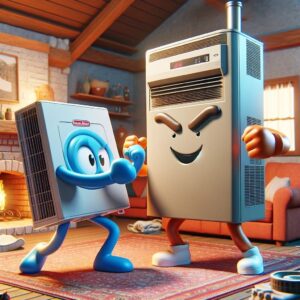
Ductless Mini-Split vs. Electric Furnace: A Comprehensive Comparison for Homeowners
When it comes to heating your home, selecting the right system is crucial for comfort, efficiency, and cost-effectiveness. Two popular options are ductless mini-split systems and electric furnaces. In this article, we’ll explore the benefits of each and delve into their real-world energy savings.
Understanding Ductless Mini-Split Systems
Ductless mini-splits are heating and cooling systems that allow you to control the temperature in individual rooms or spaces. They are composed of an outdoor compressor/condenser and one or more indoor air-handling units.
Benefits of Ductless Mini-Splits
- Energy Efficiency: Mini-splits have high SEER (Seasonal Energy Efficiency Ratio) ratings, meaning they use less energy to provide the same heating or cooling output as other systems.
- Customized Comfort: With zoned heating and cooling, you can set different temperatures in different rooms, enhancing comfort and reducing energy waste.
- Easy Installation: These systems require no ductwork, making installation less invasive and more flexible in terms of placement.
Exploring Electric Furnaces
Electric furnaces use heated coils to warm air, which is then distributed throughout your home via ductwork. They are known for their simplicity and reliability.
Benefits of Electric Furnaces
- Lower Initial Cost: Generally, electric furnaces are less expensive to install compared to other heating systems.
- Longevity: With fewer moving parts, electric furnaces often have a longer lifespan and require less maintenance.
- Indoor Air Quality: These systems can be equipped with filters and humidifiers to improve the air quality in your home.
Real-World Energy Savings
When it comes to energy savings, ductless mini-splits often come out ahead due to their higher efficiency. The absence of ducts reduces energy loss, making them 20-30% more efficient than traditional forced-air systems. On the other hand, electric furnaces, while less efficient in terms of energy use, offer a reliable and straightforward heating solution, particularly in areas with milder winters.
Conclusion
Choosing between a ductless mini-split system and an electric furnace depends on your specific needs, climate, and budget. While mini-splits offer higher energy efficiency and customizable comfort, electric furnaces provide a simple and cost-effective heating solution. Consider consulting with a professional HVAC technician to determine the best option for your home.
For more information on home heating solutions and to stay updated with the latest HVAC trends, visit christiansonsheating.com.


